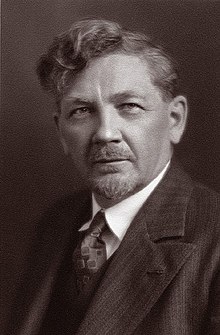Stephen Timoshenko | |
|---|---|
Степан Тимошенко | |
 Timoshenko, c. 1918 | |
| Born | Stepan Prokopovych Tymoshenko December 22 [O.S. December 10] 1878 Shpotovka, Chernigov Governorate, Russian Empire |
| Died | May 29, 1972 (aged 93) |
| Nationality | Russian Empire, then United States after about 1927 |
| Alma mater | Petersburg State Transport University |
| Known for | Timoshenko beam theory |
| Awards | Louis E. Levy Medal (1944) Timoshenko Medal (1957) Elliott Cresson Medal (1958) Fellow of the Royal Society[1] |
| Scientific career | |
| Fields | Engineering Mechanics |
| Institutions | Kiev Polytechnic Institute, Peter the Great St. Petersburg Polytechnic University, University of Michigan, Stanford University |
| Doctoral students | |
Stepan Prokopovich Timoshenko[3] (Ukrainian: Степан Прокопович Тимошенко, romanized: Stepan Prokopovych Tymoshenko; [Степан Прокофьевич Тимошенко] Error: {{Langx}}: invalid parameter: |p= (help); December 22 [O.S. December 10] 1878 – May 29, 1972), later known as Stephen Timoshenko, was a Russian[4][5][6][7] and later an American[8] engineer and academician.
He is considered to be the father of modern engineering mechanics. An inventor and one of the pioneering mechanical engineers at the St. Petersburg Polytechnic University. A founding member of the Ukrainian Academy of Sciences, Timoshenko wrote seminal works in the areas of engineering mechanics, elasticity and strength of materials, many of which are still widely used today. Having started his scientific career in the Russian Empire, Timoshenko emigrated to the Kingdom of Serbs, Croats and Slovenes during the Russian Civil War and then to the United States.[1][9][10][11][12][13][14]
- ^ a b Mansfield, E. H.; Young, D. H. (1973). "Stephen Prokofievitch Timoshenko 1878-1972". Biographical Memoirs of Fellows of the Royal Society. 19: 679–694. doi:10.1098/rsbm.1973.0025.
- ^ Stephen Prokofyevich Timoshenko at the Mathematics Genealogy Project
- ^ Elishakoff I., "Stepan Prokofievich Timoshenko", in Encyclopedia of Continuum Mechanics (H. Altenbach and A. Öchsner, eds.), pp. 2552-2555, Berlin: Springer, 2020
- ^ The Life and Work of Stephen P. Timoshenko
- ^ The Chartered Mechanical Engineer. The Institution. 1963.
- ^ University of Michigan. Faculty History Project
- ^ Moon, Francis C. (2013-11-19). Social Networks in the History of Innovation and Invention. Springer Science & Business Media. ISBN 978-94-007-7528-2.
- ^ "Stephen Timoshenko". www.nndb.com. Retrieved 2024-09-23.
- ^ Timoshenko, Stephen P. (1968). As I Remember; The Autobiography of Stephen P. Timoshenko. Princeton, Van Nostrand.
- ^ C. Richard Soderberg (1982). Stephen P. Timoshenko, 1878-1972: A biographical memoir. The National Academies Press (National Academy of Sciences).
- ^ Read "Biographical Memoirs: Volume 53" at NAP.edu.
- ^ Encyclopedia of Ukraine, vol. 19 (1993). Stephen Timoshenko. Toronto: University of Toronto.
{{cite book}}: CS1 maint: numeric names: authors list (link) - ^ В. Борисов, Тимошенко Степан Прокофьевич,Institute of the History of the Natural Sciences and Technology of the Russian Academy of Science
- ^ Писаренко Г.С. Степан Прокофьевич Тимошенко. М., 1991.